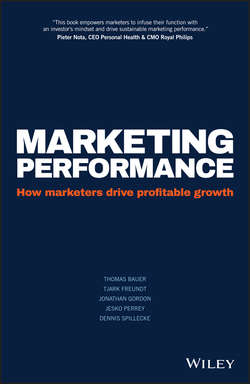Читать книгу Marketing Performance - Freundt Tjark - Страница 9
На сайте Литреса книга снята с продажи.
1 – Budget sizing: Combine multiple lenses to right-size your marketing budget
Saturation analysis: Review your budget in light of the expected return it will generate
ОглавлениеYour competitors are going overboard with advertising spending. The noise they create calls for massive investments on your part as well, as do your ambitious growth targets for the company. And still it can be a bad idea to increase the marketing budget. Why? Because it may not pay off. Even if both outside-in benchmarking and inside-out activity planning lead you to believe a higher investment is required, the figure you arrive at may actually be beyond the efficient range. The disguised case in Exhibit 1.4 shows how the marginal ROI declines as the size of the budget increases.
Exhibit 1.4 Saturation analysis.
Source: McKinsey
As you can see from the shape of the curve, saturation is not a black-and-white affair. Long before your total budget reaches the saturation point, incremental returns generated by additional marketing investment begin to level off. In other words, your budget becomes less efficient the more you spend. As you get close to the tipping point, we encourage you to assess every new marketing activity, every additional instrument, and every request for a budget increase from one of your direct reports or product managers in light of the expected return. If your current budget already exceeds the saturation point, consider decreasing the budget to increase the relative return on marketing investment.
Additionally – or alternatively – you may also want to change the way you spend, based onthis “marginal benefit” mindset. In this book, we will present a wide range of approaches you can apply to quantify and optimize the expected return on a given marketing instrument or activity. Granular growth analysis will help you find the investment units in which your budget is bound to have the biggest impact (Chapter 2). Insights derived from purchase funnel analysis will point you to the stages in a consumer's decision journey at which marketing investments are likely to be most worthwhile (Chapter 3). A common currency will help you compare different marketing instruments in light of their real reach per cost (Chapter 5). Creative storytelling is a great way to engage with consumers, often at very little cost because of the viral effects and free editorial coverage it generates (Chapter 4). Advanced analytical approaches let you optimize your mix across instruments (Chapter 6). Smart activation allows you to get the most out of your investments in specific instruments (Chapter 7). Don't hesitate to ask your trusted agencies for ROI estimates, and by all means have your team challenge their assumptions. Tying agency remuneration to marketing ROI can be a great way to motivate service providers to help you make your budget more efficient (Chapter 8). Screen the marketing technology landscape for solutions that enable you to monitor and manage marketing performance on a continuous basis (Chapter 9), and build an organization that is sufficiently agile and adaptive to react to relevant changes in market dynamics, competitor moves, instrument availability, and consumer behaviour (Chapter 10).
Конец ознакомительного фрагмента. Купить книгу
